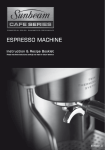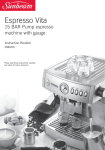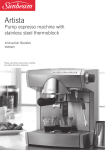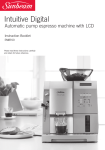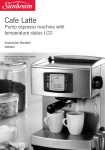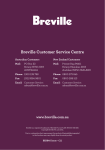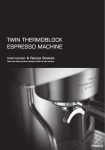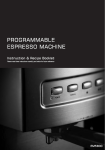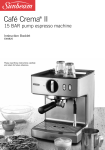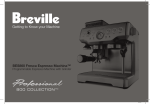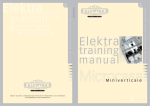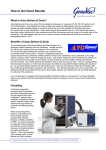Download Instruction Booklet
Transcript
Waiting on Front Cover from Energi Contents Sunbeam's Safety Precautions 1 Features of your Café Series® Espresso Machine 2 Using your espresso machine 7 Advanced Programming 10 Preparing your espresso machine for the first time 14 Guide to coffee making 15 Guide to milk texturing 17 Espresso recipes 18 Care and cleaning 20 Coffee Thermoblock Cleaning Cycle 22 Descaling Cycle for both the Coffee and Steam Thermoblocks 23 Important instructions – retain for future use. Sunbeam’s Safety Precautions SAFETY PRECAUTIONS FOR YOUR SUNBEAM ESPRESSO MACHINE • Always place the unit on a flat, level surface. • Do not operate without water in reservoir. Fill reservoir with only clean and cold water. Observe the maximum filling volume is 3 litres. • Do not remove the filter handle during the espresso pour or water flow as the unit is under pressure. Removing the filter handle during either of these operations can lead to a scalding or injury. • The steam wand and hot water tap become very hot during texturing milk and water flow. This may cause burns in case of contact, therefore avoid any direct contact with the steam wand or hot water tap. • Always disconnect the plug from the power outlet prior to cleaning the espresso machine or if there is any problem during the coffee making process. • Do not allow the power cord to come into contact with the hot parts of the espresso machine, including the cup warming plate, hot water tap and steam wand. • Do not place hands directly under the steam, hot water or coffee pour as this can lead to a scalding or injury. Sunbeam is very safety conscious when designing and • Do not use an appliance for any purpose other than manufacturing consumer products, but it is essential its intended use. that the product user also exercise care when using • Do not place an appliance on or near a hot gas an electrical appliance. Listed below are precautions flame, electric element or on a heated oven. which are essential for the safe use of an electrical • Do not place on top of any other appliance. appliance: • Do not let the power cord of an appliance hang over • Read carefully and save all the instructions the edge of a table or bench top or touch any hot provided with an appliance. surface. • Always turn the power off at the power outlet before • Do not operate any electrical appliance with a you insert or remove a plug. Remove by grasping damaged cord or after the appliance has been the plug - do not pull on the cord. damaged in any manner. If damage is suspected, • Turn the power off and remove the plug when the return the appliance to the nearest Sunbeam appliance is not in use and before cleaning. Appointed Service Centre for examination, repair • Do not use your appliance with an extension cord or adjustment. unless this cord has been checked and tested by a • For additional protection, Sunbeam recommend qualified technician or service person. the use of a residual current device (RCD) • Always use your appliance from a power outlet of with a tripping current not exceeding 30mA in the voltage (A.C. only) marked on the appliance. the electrical circuit supplying power to your appliances. • This appliance is not intended for use by persons (including children) with reduced physical, sensory • Do not immerse the appliance in water or any other or mental capabilities, or lack of experience and liquid unless recommended. knowledge, unless they have been given supervision • Appliances are not intended to be operated by or instruction concerning use of the appliance by a means of an external timer or separate remote person responsible for their safety. control system. • Children should be supervised to ensure that they • This appliance is intended to be used in household do not play with the appliance. and similar applications such as: staff kitchen areas • The temperature of accessible surfaces may be in shops, offices and other working environments; high when the appliance is operating. farm houses; by clients in hotels, motels and other residential type environments; bed and breakfast • Never leave an appliance unattended while in use. type environments. If you have any concerns regarding the performance and use of your appliance, please visit www.sunbeam.com.au or contact the Sunbeam Consumer Service Line. Ensure the above safety precautions are understood. 1 Features of your Café Series® Espresso Machine Warming plate The large warming plate effectively pre-warms cups helping to retain the essential characteristics true of espresso - sweet, rich tasting and aroma. Steam control dial Used to open and close the steam. Temperature sensing steam wand The patented temperature sensing steam wand ensures milk is textured to the correct temperature, also enhancing the sweetness and taste. Also fitted with a dedicated thermoblock and pump provides an instant and constant supply of powerful dry steam for achieving silky, dense and rich milk. The commercial 360° ball joint allows the steam wand to be moved into the ideal position. Espresso gauge The gauge measures the resistance to the espresso pour and at a glance the coffee maker can gauge the quality of the espresso pour. Commercial size group head Commercial size sloping group handle with tamping pad The sloping handle is designed for improved ergonomic use and when rested on the bench provides an even tamping surface, resulting in a better tasting espresso. Removable drip tray and grill The large capacity die-cast metal drip tray is lined with plastic, preventing staining from espresso oils, lightweight for easy removal and designed with no dirt traps for simple wipe down cleaning. Accessories All the essential accessories to make an authentic café-quality espresso – 600ml stainless steel milk texturing jug, barista coffee tamp and spoon for measuring out coffee. 2 Single filter basket Double filter basket Milk temperature gauge The gauge reads the temperature of the milk to help the coffee maker achieve the perfect temperature everytime. Control board with dual gauges, low water indicator & large buttons Slightly angled for easy viewing the control board houses all the information the coffee maker needs to create a great tasting espresso. Programmable control panel An easy to use control panel provides the choice of manual operation or utilising the programmed 1 and 2 cup espresso serve pours. Hot water control dial Used to open and close the hot water. Hot water wand Dispenses a controlled flow of hot water. 3 litre water reservoir Removable 3 litre water reservoir is fitted with an anti-calc filter and can be filled from the top or is removable from behind. FEATURES YOU CAN'T SEE Twin pump and thermoblock allows you to texture milk and brew espresso at the same time. 15 BAR Italian espresso pump fitted with a pressure relief system. Twin thermoblocks with stainless steel tubing. PID technology controls water temperature precisely for both espresso and steam functions. Pre-infusion; 3 programs to choose from. Brass collar is durable and ideal for frequent use. Advanced Programming to adjust pump and temperature settings for optimal steam and brewing performance. Stainless steel and die-cast metal design Power saving mode Cleaning Disc Measuring spoon Tamp 600ml jug 3 Features of your Café Series® Espresso Machine continued Required Espresso Pressure The 15 BAR Italian pump produces the required pressure for brewing espresso consistently. Fitted with a pressure relief system, ensures that any remaining pressure after the extraction is released into the drip tray, allowing for quick, successive brews. Temperature Stability Independent thermoblock heating systems are lined with stainless steel and fitted with PID technology, controlling the water temperature from the thermoblock to the group head, ensuring only the most appreciated characteristics of espresso are exposed - TASTE, BODY and AROMA. Twin Pump & Thermoblock True to commercial use, the unique twin pumps and twin thermoblocks allows the coffee maker to texture milk and pour an espresso simultaneously. Espresso Gauge The espresso gauge is an indicator of the quality of the espresso pour and should be used as a guide. It measures the pressure or resistance created by water being pumped through the tamped coffee grinds in the group handle. Whilst the needle is within the target area on the gauge it indicates that a quality serve of espresso has been made. This is indicated by a slow, but flowing pour of espresso with a consistency similar to that of dripping honey. The crema should be dark golden in colour. 4 Should the needle fail to reach the target area this is an indication that the serve of espresso is ‘under-extracted’. This occurs when water passes too quickly through the tamped coffee grinds and is an indication that either the grind needs to be made finer or the filter basket has been under-dosed. The pour is quick and light in colour and the resulting crema is thin with a creamy light brown colour. Optimum Pour Under Extracted Pour Over Extracted Pour When the needle goes beyond the target area it is an indication that the serve of espresso is ‘over-extracted’. This occurs when the water passes very slowly through the tamped coffee grinds and is an indication that either the grind is too fine or the filter basket has been over-dosed. In this situation the hot water is in contact with the coffee grinds for too long thus creating a burnt and bitter tasting espresso. This is characterised by the espresso only slowly dripping during the entire pour and the crema is very dark. Features of your Café Series® Espresso Machine continued Milk Temperature Gauge The 4 BAR steam pump produces instant, constant steam pressure for texturing milk. An important factor when creating milk foam is temperature. The steam wand integrates a patented temperature sensing device that relays the temperature of the milk during texturing to the milk temperature gauge on the control board. Commercial Size Group Head & Group Handle The group head, group handle and filters are designed to commercial specifications using brass and stainless steel components. These elements help contribute to the preparation of an espresso serve, as it allows the coffee maker to pack the necessary amount of coffee grinds, which then expand firmly and evenly onto the shower screen. As most coffees are milk based, this highlights the importance of getting the milk right. The end product should be smooth, velvety with none or barely visible bubbles. Milk textured to the optimum temperature improves and sweetens the taste. The sloping group handle gives the coffee maker a more ergonomic action when attaching and removing the handle from the group head. Also when rested on the bench the filter basket sits level, this results in a more even tamp ensuring an even extraction. The under-side of the basket has a tamping pad so the coffee maker can locate the group handle onto the side of the bench and once again ensures the basket sits level. 5 Features of your Café Series® Espresso Machine continued Control Board Slightly angled for easy viewing, the control board communicates the essential information the coffee maker needs to create a great tasting coffee. Also housing a large, easy to use push buttons for espresso and programming functions, the coffee maker is provided with the choice of ‘MANUAL’ operation or using either of the programmed coffee pour volumes for 1 or 2 cups. The programmed espresso pour is set to 30mls per cup while the PROGRAM function allows users to personalise and save their own espresso volumes. Pre-Infusion There are 3 programmable pre-infusion settings to help achieve the perfect extraction. Pre-infusion is programmed into the MANUAL, 1 CUP and 2 CUP espresso operations. 1.Constant - delivers a constant water temperature and flow from start to finish. 2.Progressive - small amounts of water are released onto the tamped coffee prior to a steady water flow. 2.Infusion - small amount of water is released onto the tamped coffee, then their is a short infusion time before a steady flow of water is released. 6 Anti-Calc Filter An Anti-Calc water filter reduces impurities that taint the flavour and odour of the water, improving the taste and aroma of the espresso brewed. Additionally, scale build up is slowed reducing the frequency of cleaning required. The Anti-Calc water filter fitted inside the 3 litre water reservoir has a 12 month life for domestic use and a 3 month life for commercial use. Note: Contact Sunbeam on 1300 881 861 for replacement filters (Part code: EM69101). Note: The espresso machine can operate normally without the filter and is easily removed by gently pulling it out. Using your espresso machine Power Press the POWER button once to turn the espresso machine on. The machine will beep once and the power button will flash red, this is to indicate that your machine is on and is heating up. Note: Before turning on the espresso machine ensure that the steam and hot water control dials are in the OFF position. When the machine has reached READY MODE, the power button will stop flashing and the POWER, MANUAL, 1 & 2 CUP buttons will illuminate red. The espresso machine is now ready to use. Power Saving Mode After 1 hour of non-use the espresso machine will automatically switch to POWER SAVING MODE. Once the espresso machine is in POWER SAVING MODE all the lights on the buttons will dim. While in POWER SAVING MODE the espresso machine powers down to 75% of power. After a further 4 hours of non-use the espresso machine will beep once and then turn off. To bring the espresso machine out of POWER SAVING MODE you simply need to press any of the buttons on the control board. Figure 1 1 Cup Espresso Pour The 1 CUP function removes the guess work and is programmed to pour 30mls of espresso. Tip: We recommend using the 1 CUP basket when using the programmed 1 CUP function. To use this operation press the 1 CUP button once to start the espresso pour. The pour will start with the pre-infusion and then the espresso pour will follow. The espresso pour will stop after the 1 CUP volume has been extracted. Note: When using the 1 CUP function, the lights on the MANUAL and 2 CUP buttons will go off and the lights on the POWER and 1 CUP buttons will remain on. Using Manual Operation The MANUAL button gives the coffee maker complete control over the length of the espresso pour. To use this operation press the MANUAL button once to start the espresso pour. The pour will start with the pre-infusion and then the espresso pour will follow. Press the MANUAL button again to stop the espresso pour. Note: When using the MANUAL operation, the lights on the 1 & 2 cup buttons will go off and the lights on the POWER and MANUAL buttons will remain on. Figure 2 Note: When using the 1 CUP function the coffee maker can stop the espresso pour at any time by pressing the MANUAL, 1 or 2 CUP buttons. 7 Using your espresso machine continued 2 Cup Espresso Pour The 2 CUP function removes the guess work and is programmed to pour 60mls of espresso. Tip: We recommend using the 2 CUP basket when using the programmed 2 CUP function. Steam To activate the steam, turn the steam dial to the ON position. This will open the steam function with an instant and constant supply of powerful steam for texturing milk. To use this operation press the 2 CUP button once to start the espresso pour. The pour will start with the pre-infusion and then the espresso pour will follow. The espresso pour will stop after the 2 CUP volume has been extracted. Note: When using the 2 CUP function, the lights on the MANUAL and 1 CUP buttons will go off and the lights on the POWER and 2 CUP buttons will remain on. Figure 4 To turn the steam off, turn the steam dial to the OFF position. Tip: To ensure optimum steam performance we recommend that at the end of texturing milk, the coffee maker wipes the tip of the steam wand clean of any milk residue. Figure 3 Note: When using the 2 CUP function the coffee maker can stop the espresso pour at any time by pressing the MANUAL, 1 or 2 CUP buttons. Hot Water To activate the hot water function, turn the hot water dial to the ON position. This will dispense an instant flow of hot water. Figure 5 Tip: This feature is ideal for pre-warming cups/glasses or for making a Long Black. 8 Using your espresso machine continued Programming 1 Cup Volume PREPARE the 1 cup filter with coffee and tamp. PLACE a cup under the espresso pour spouts. PRESS the PROGRAM button. PRESS the 1 CUP button to start the espresso pour. Press the 1 CUP button again once the desired volume of espresso has been extracted. The espresso machine will beep twice to indicate the new program for the 1 CUP operation has been set. Resetting the Factory Settings To revert back to the espresso machines factory settings; 1.Ensure the espresso machine is plugged in and switched on at the power outlet. Note: DO NOT press the POWER button on the espresso machine. 2.PRESS and HOLD DOWN the MANUAL button. 3.While still holding down the MANUAL button, briefly PRESS the POWER button and then release the MANUAL button. 4.4 beeps will sound and the machine will power on. 2 Cup Volume PREPARE the 2 cup filter with coffee and tamp. PLACE 2 cups under the espresso pour spouts. PRESS the PROGRAM button. PRESS the 2 CUP button to start the espresso pour. Press the 2 CUP button again once the desired volume of espresso has been extracted. The espresso machine will beep twice to indicate the new program for 2 CUP operation has been set. 9 Advanced Programming Pre-infusion Programming There are 3 programmable pre-infusion settings to help achieve the perfect extraction; Infusion; a small amount of water is released onto the tamped coffee, and then there is a short infusion time before a steady flow of water is released. Your espresso machine comes with this selection as a factory setting. Constant; delivers a constant water temperature and flow from start to finish. Progressive; small amounts of water are released onto the tamped coffee prior to a steady water flow. 1.Ensure the espresso machine is plugged in and switch on at the power outlet. Note: DO NOT press the POWER button on the espresso machine. 2.PRESS and hold down both the MANUAL and 1 CUP buttons. 3.While still holding down the MANUAL and 1 CUP buttons briefly PRESS the POWER button and then release both the MANUAL and 1 CUP buttons. To indicate you have activated the programmability of the pre-infusion selections, a light on one of the buttons will illuminate; 1 CUP = Infusion (Factory setting) 2 CUP = Progressive Pre-infusion MANUAL = Constant Pre-infusion This light will remain on for up to 5 seconds before automatically returning to factory settings if no action is taken. The espresso machine will then power on. 10 Figure 6 4.PRESS and RELEASE one of the buttons below depending on the required temperature adjustment; Constant = PRESS the MANUAL button Infusion = PRESS the 1 CUP button Progressive = PRESS the 2 CUP button When the new pre-infusion program has been selected the espresso machine will beep twice. 5.The espresso machine will then automatically power on. Advanced Programming continued Espresso Thermoblock Temperature The water temperature of the espresso machine has been calibrated to the precise temperature of 92°C at the group head. However the coffee maker can adjust the temperature of the water at the group head in increments of 2°C up and down, should it be desired. 4.PRESS and RELEASE one of the buttons below depending on the required temperature adjustment; +2°C = PRESS the 2 CUP button 1.Ensure the espresso machine is plugged in and switch on at the power outlet. Note: DO NOT press the POWER button on the espresso machine. When the new temperature setting has been selected the espresso machine will beep twice. 2.PRESS and hold down the 1 CUP button. 3.While still holding down the 1 CUP button briefly PRESS the POWER button and then release the 1 CUP button. To indicate you have activated the programmability of the espresso thermoblock temperature, a light on one of the buttons will illuminate; 1 CUP = Factory setting PROGRAM = +4°C MANUAL = -2°C POWER = -4°C This light will remain on for up to 5 seconds before automatically returning to factory settings if no action is taken. The espresso machine will then power on. -2ºC Factory Setting -2°C = PRESS the MANUAL button -4°C = PRESS the POWER button 5.The espresso machine will then automatically power on. Steam Thermoblock Temperature The steam temperature of this espresso machine has been calibrated to deliver a powerful, constant supply of dry steam for texturing milk. The temperature of the steam can be modified in increments. of 5°C up and down should it be desired. 1.Ensure the espresso machine is plugged in and switch on at the power outlet. Note: DO NOT press the POWER button on the espresso machine. 2 CUP = +2°C -4ºC +4°C = PRESS the PROGRAM button +2ºC +4ºC 2.PRESS and hold down the 2 CUP button. 3.While still holding down the 2 CUP button briefly PRESS the POWER button and then release the 2 CUP button. To indicate you have activated the programmability of the steam thermoblock temperature, a light on one of the buttons will illuminate; 1 CUP = Factory setting 2 CUP = +5°C PROGRAM = +10°C MANUAL = -5°C POWER = -10°C 11 Advanced Programming continued This light will remain on for up to 5 seconds before automatically returning to factory settings if no action is taken. The espresso machine will then power on. -10ºC -5ºC Factory Setting +5ºC +10ºC To indicate you have activated the programmability of the steam pump rate, a light on one of the buttons will illuminate; 1 CUP = Factory setting 2 CUP = -0.1 sec off PROGRAM = -0.2 sec off MANUAL = +0.1 sec off 4.PRESS and RELEASE one of the buttons below depending on the required temperature adjustment; +5°C = PRESS the 2 CUP button +10°C = PRESS the PROGRAM button -5°C = PRESS the MANUAL button -10°C = PRESS the POWER button When the new temperature setting has been selected the espresso machine will beep twice. 5.The espresso machine will then automatically power on. Steam Pump Rate The steam pump rate of this espresso has been set at 0.3 seconds on and 0.5 seconds off. Modifying the steam pump rate enables you to make the steam wetter or dryer and aids in the delivery of a powerful, constant, dry steam – ideal for texturing milk. The steam pump rate (off time) can be modified in increments of plus or minus 0.1 seconds should it be desired. 1.Ensure the espresso machine is plugged in and switch on at the power outlet. Note: DO NOT press the POWER button on the espresso machine. 2.PRESS and hold down the PROGRAM button. 3.While still holding down the PROGRAM button briefly PRESS the POWER button and then release the PROGRAM button. 12 POWER = +0.2 sec off This light will remain on for up to 5 seconds before automatically returning to factory settings if no action is taken. The espresso machine will then power on. +0.2 sec +0.1 sec Factory off off Setting -0.1 sec -0.2 sec off off 4.PRESS and RELEASE one of the buttons below depending on the required temperature adjustment; -0.1 sec = PRESS the 2 CUP button (delivers a wet steam) -0.2 sec = PRESS the PROGRAM button (delivers a wetter steam) +0.1 sec = PRESS the MANUAL button (delivers a dry steam) +0.2 sec = PRESS the POWER button (delivers a dryer steam) When the new pump rate setting has been selected the espresso machine will beep twice. 5.The espresso machine will then automatically power on. Advanced Programming continued Resetting the Factory Settings To revert back to the espresso machines factory settings; To indicate you have activated the programmability of the power saving mode, a light on one of the buttons will illuminate; 1.Ensure the espresso machine is plugged in and switch on at the power outlet. Note: DO NOT press the POWER button on the espresso machine. 1 CUP = Power down after 1 hour of inactivity and then turn off after a further 4 hours of inactivity (Factory setting) 2 CUP = Turn off after 26 hours of inactivity PROGRAM = Does not turn off MANUAL = Turn off after 8 hours of inactivity POWER = Turn off after 30minutes of inactivity This light will remain on for up to 5 seconds before automatically returning to factory settings if no action is taken. The espresso machine will then power on. 2.PRESS and HOLD DOWN the MANUAL button. 3.While still holding down the MANUAL button, briefly PRESS the POWER button and then release the MANUAL button. 4.4 beeps will sound and the machine will power on. Power Saving Mode After 1 hour of non-use the espresso machine will automatically switch to power saving mode. Once the espresso machine is in power saving mode all the lights on the buttons will dim. While in power saving mode the espresso machine powers down to 75% of power. After a further 4 hours of non-use the espresso machine will beep once and then turn off. The time of inactivity before the espresso machine enters into power saving mode can be adjusted if so desired; 1.Ensure the espresso machine is plugged in and switch on at the power outlet. Note: DO NOT press the POWER button on the espresso machine. 2.PRESS and HOLD DOWN the MANUAL and PROGRAM buttons. 3.While still holding down the MANUAL and PROGRAM buttons briefly PRESS the POWER button and then release both the MANUAL and PROGRAM buttons. Figure 7 4.PRESS and RELEASE one of the buttons below depending on the power saving mode desired; 26 hours = PRESS the 2 CUP button Does not turn off = PRESS the PROGRAM button 8 hours = PRESS the MANUAL button 30 minutes = PRESS the POWER button When the new power saving mode setting has been selected the espresso machine will beep twice. 5.The espresso machine will then automatically power on. 13 Heading your espresso machine Preparing for the first time • Ensure the espresso machine is always positioned onto a dry, stable bench top. • Ensure all packaging has been removed from the espresso machine and the drip tray with grill is in place. • Fill the espresso machine with water; 1.Simply lift the lid of the water reservoir at the top of the espresso machine and using a jug, fill with fresh cold water or filtered water. 2.Alternatively slide out the water reservoir from the back of the espresso machine and fill with fresh cold water or filtered water. Then replace the water reservoir, ensuring it is firmly in place. • Insert the power cord into a 230-240V AC power outlet and switch the power on. • Press the POWER button on the espresso machine. The POWER button will start flashing, this indicates that your espresso machine is on and is heating up. 14 • When the red light on the POWER button stops flashing and turns to a constant red light this indicates that the espresso machine is now at temperature and is in READY MODE. • At this point glasses and cups can be placed on the warming plate for pre-heating. • Fit the group handle with either the single or double filter basket and secure to the group head on the espresso machine. • Place a sufficiently large container under both pour spouts and press the MANUAL button. Water will start to run through. Note: As a safety mechanism the espresso machine is programmed to automatically stop the water flow after 240mls, therefore you will need to press the MANUAL button again to restart the water flow. • Continue to allow the water to run through until the water reservoir is empty. Heading Guide to coffee making PRE-HEATING Glasses Pre-heat glasses and cups by filling them with hot water as this will assist to preserve the crema of the espresso and also help maintain the temperature of the espresso. Just prior to making your espresso glasses and cups can be pre-heated using the hot water feature on your espresso machine. Otherwise glasses and cups can be stored on the warming tray of the espresso machine; this will also assist in pre-heating. Group Handle and Filter baskets This is important especially for the first coffee being made, as a cold group handle can significantly decrease the temperature of the water at the point of extraction. This in turn will alter the quality and characteristics of the resulting espresso extraction. An easy way to pre-heat the group handle and filter basket is to fit the group handle with a filter basket. Hold the group handle under the group head, press the MANUAL button and allow the hot water to flow over the group handle. Rotate the group handle so both the underside of the group handle and the filter basket is preheated. You may need to press the MANUAL button again to ensure the group handle and filter basket is properly pre-heated. DOSING and TAMPING • Dry wipe the basket. • Grind evenly and directly into the centre of the filter basket. • Fill the filter basket with ground coffee to the rim. • Using the tamper, tamp straight down, this is going to create more space for some more coffee. • Grind some more coffee to a similar level in the filter basket and using the tamper again to create some more space. One last time grind some more coffee into the filter basket to the rim. • This time lock the group handle into the side of the bench and using the tamper apply firm downward pressure. Brush any loose coffee off the rim of the basket into the centre and tamp down again, this time twist the tamper to seal the top of the coffee. • Wipe the rim of the filter basket free of any loose coffee grinds and use immediately. Dry the filter basket before filling with coffee. 15 Heading Guide to making coffee continued The Espresso Pour Great coffees start with freshly roasted beans that will deliver a sweet espresso that will be rich in texture, body and aroma. Controlling each part of the coffee making process is the real secret. • Never extract any more than 30mls of espresso. • Always purge water from the group head before locking in the group handle with coffee, this will dislodge any ground coffee residue from the group head. The way the espresso pours will tell you everything. What you are looking for is; 1.Infusion time; when pressurised water is being forced through the ground coffee. 2.Colour of the espresso; should be dark brown. 16 3.Resistance; looking for a thickness, or a nice ooziness like dripping honey, with resistance at about 2/3 from the spouts to the bottom of the cup. It’s going to fall and pull back up. 4.Even extraction; not extremely tight at the beginning or pouring excessively fast at the end. 5.Look for colour change; when the espresso changes from a dark brown to a creamy or light colour the sweetest flavours and oils have been extracted and this usually happens around the 25-30ml mark, after which the espresso pour is finished. Heading Guide to milk texturing What you want to achieve is silky thick rich milk that has been heated to between 60-65°C. The steam coming out of the machine will only heat the milk, it is up to the coffee maker to aerate the milk in a way that allows the creation of beautifully textured micro foam and it’s all about the positioning of the steam tip and how you move the jug. • Always start with fresh cold milk and a clean jug. • Fill the jug to approximately ½ way. • Purge the steam wand. • Rest the spout of the milk jug up against the steam wand. Place the steam tip just under the surface of the milk and just off centre. • Turn on the steam. • Gently lower the jug slowly to create the amount of desired foam for the style of coffee drink you are creating. • The more control you have during this stage of the milk texturing process the denser and smoother the foam. • Now listen for the hissing sound, that’s an indicator that you’re drawing air into the milk in a controlled fashion. • After you have created the amount of foam you need for the style of drink you’re making keep the jug steady and allow the milk to come up to temperature, which is between 60-65°C. • Remember this process is about keeping the milk spinning and maintaining the same position from where you started. • When the milk reaches the desired temperature turn the steam off. Remove the jug from the wand, wipe the steam wand with a clean damp cloth and give it a quick bust of steam to remove any milk that has been sucked up the steam wand. • If you have any large surface bubbles, gently tap the jug on the bench to collapse these. • Roll the jug to keep the milk and foam together. • Take your glass or cup of espresso and rest the pouring spout against the rim of the cup and pour in one steady motion. 17 Espresso recipes ESPRESSO (SHORT BLACK) MACCHIATO Espresso is a concentrated, full bodied coffee with a stable layer of cream on top – known as ‘crema’. An espresso is the foundation of all café coffee. Variations are achieved by adding different amounts of milk and froth. Macchiato, Italian for ‘to stain or mark’. Traditionally served as a standard espresso with a dash of milk and a small dollop of froth into the middle of the ‘crema’. • 90mL espresso glass or demitasse cup • 90mL espresso glass or demitasse cup • single or double espresso • single espresso (30-35mL) • marked with steamed milk froth LONG BLACK FLAT WHITE A standard espresso with hot water, served in a regular coffee cup or mug. The hot water is added first so that the ‘crema’ is maintained. Another old favourite, the Flat White is an espresso with steamed milk, served in a regular coffee cup or mug. The layer of frothed milk on top should be 2mm to seal the coffee. • 190mL cup • hot water (to taste) • single or double espresso • 190mL cup • single or double espresso • steamed milk 18 Espresso recipes continued CAFFE LATTE CAFFE MOCHA An espresso with steamed milk, typically served in a glass. The layer of frothed milk on top should be 10mm to seal the coffee. Made in a similar way to a cappuccino but with the addition of drinking chocolate. Simply stir the chocolate into the espresso prior to adding the steamed milk and froth. • 220mL glass or cup • single or double espresso • 190-240mL cup or tall glass • steamed milk • single or double espresso • two teaspoons of drinking chocolate • two-thirds milky coffee, one-third froth CAPPUCCINO CON PANNA This delicious drink is an espresso with steamed milk, topped with creamy froth and a dusting of chocolate. The resulting drink is approximately two-thirds milky coffee, onethird froth. A variation on the original Vienna coffee, this delicious drink is made up of an espresso topped with lightly whipped cream. It can also be dusted with cinnamon or drinking chocolate. • 190-240mL cup • 190mL cup • single or double espresso • single or double espresso • two-thirds milky coffee, one-third froth • lightly whipped cream • dusted with chocolate • dusted with cinnamon or chocolate 19 Care and cleaning The coffee making process involves extracting oils out of coffee grinds to make espresso coffee. Deposits of these oils build up over time and affect the taste of the coffee and operation of the espresso machine. Regular cleaning to remove these oils is essential and will maintain the quality of the coffee the espresso machine produces and result in less maintenance being required. This is easy to do by following a few quick and easy cleaning steps after each coffee making session; Cycle water through the group head, Purge steam through the steam wand, Wipe the steam wand clean with a damp cloth immediately after use, Remove the filter basket from the filter handle and clean away any old coffee oils, and Empty the drip tray and rinse. Important: Never wash any of the espresso machine parts or accessories in the dishwasher. brush to remove them. Also you can use the cleaning pin which is supplied with the espresso machine. The cleaning pin is attached to the inside of the top fill lid, located at the top of the espresso machine. The cleaning pin has two pins at either end the shorter of the two is for cleaning out the holes in the filter basket. Group head rubber seal The group head seal is located on the underside of the group head and creates a seal against the filter handle during the espresso pour. Note: During long periods of non-use we recommend that the filter handle not be left attached to the group head as this will reduce the life of the seal. Over time the seal will loose its elasticity and require replacement, depending on use usually every 12 months. Signs that the seal is deteriorating are when the group handle cannot create the necessary seal and steam and or water escapes from around the group head during the espresso pour. Drip tray and grill Remove the grill and drip tray at regular intervals to empty. Clean with water and a little non-abrasive washing up liquid, rinse and dry. Note: Contact Sunbeam on 1300 881 861 should you think that the group head seal needs replacing. Please do not attempt to change the seal without first consulting Sunbeam. Group head, group handle & filter baskets The filter baskets and group handle should be rinsed with warm water after each use and then dried thoroughly. Cup warming plate, hot water tap and exterior Wipe over the unit with a damp cloth and wipe dry. Do not use abrasives or metal scourers as these will scratch the exterior surface. To clean the group head of any old coffee grinds cycle water through and wipe the group head and around the inside rim with a damp cloth. Should the holes in the filter baskets become clogged with coffee grinds use a fine bristled 20 Care and cleaning continued Steam wand Keeping the steam arm clean is essential to ensure maximum efficiency of the steam function. A build up of caramelised/dried milk on the steam wand will impair the steaming and texturing ability of the espresso machine. Important: Wipe the steam wand clean with a damp cloth immediately after each use and purge a small amount of steam. Should the milk dry/caramelise on the steam wand, simply wrap the wand with a clean damp cloth, turn the steam wand over the drip tray and turn the steam on for approximately 10 seconds. With the cloth still on the steam wand leave to soak for about 5 minutes and you will find that after this time the dry/caramelised milk will easily wipe away. Repeat process if still dirty. Important: Never clean the steam wand with an abrasive pad as this will damage the steam wand. Should the steam wand become blocked, supplied with the espresso machine is a cleaning pin. The cleaning pin is attached to the inside of the top fill lid, located at the top of the espresso machine. The cleaning pin has two pins at either end - the longer of the two is for cleaning the hole in the base of the steam nozzle. Should the steam wand remain blocked unscrew the steam nozzle from the steam wand. Clean the steam nozzle by once again using the cleaning pin then flush under running water. 21 Coffee Thermoblock Cleaning Cycle Deposits of coffee oils build up over time and affect the taste of the coffee and operation of the espresso machine. Therefore the group head will require regular cleaning. It is recommended that the group head is cleaned at a minimum every 3 months, this will vary depending on the frequency of use. 1. Remove the water reservoir and rinse clean. With fresh water completely fill and replace the reservoir. 2. Remove the cleaning disc which is inside of the top fill lid, located at the top of the espresso machine. 3. Fit the group handle with the double filter basket. 4. Position the cleaning disc into the double filter basket. 5. Place a Sunbeam Espresso Machine Cleaning Tablet (EM0020) into the filter basket that is now also fitted with the cleaning disc and secure the group handle to the group head. 6. Place a sufficiently large container under both pouring spouts. Starting the cleaning cycle 7. Insert the power cord into a 230-240V AC power outlet and switch the power ‘ON’. Note: DO NOT press the POWER button on the espresso machine 8. Press and hold down the 1 CUP and 2 CUP buttons. While still holding down the 1 CUP and 2 CUP buttons briefly press the POWER button. As the lights on the control panel start to chase from left to right release the 1 CUP and 2 CUP buttons. 22 Note: The lights on the control panel will continue to chase until the cleaning cycle is completed, this will take approximately 7 minutes. Note: During the cleaning cycle all other espresso machine operations will be locked until the cleaning cycle is completed. Should the cleaning cycle be accidentally started it can be cancelled by switching the power ‘OFF’ at the power outlet, or by pressing the POWER button. 9. When the cleaning cycle is completed the lights on the control panel will stop chasing and the espresso machine will beep 4 times. Following this, the lights above the POWER, MANUAL, 1 CUP and 2 CUP buttons will come on, signalling that the machine is ready to use. 10.Remove the container from under the pouring spouts and empty. 11.Remove the group handle from the group head. 12.Remove the cleaning disc from the group handle and return to the storage compartment. 13.Remove the double filter basket from the group handle and wash in warm soapy water. Rinse well and dry. 14.The espresso machine is now ready for use. Descaling Cycle for both the Coffee and Steam Thermoblocks Scale is a surface build up of minerals that naturally occur over time in all appliances that are involved with the heating of water. Therefore the espresso machine will require occasional descaling. It is recommended that the espresso machine is descaled every 4-6 months; this will vary depending on the frequency of use and water hardness. 1. Remove the water reservoir and rinse clean. Fill with fresh cold water and replace the reservoir. 2. Using a screwdriver unscrew the filter/ shower screen from the underside of the group head and clean under running water. 3. Replace the filter/shower screen and screw in position. 4. Place a large container under the group head and also position the steam wand so water from both the group head and the steam wand will fall into the container. 5. Turn the steam dial to the ON position. Important: The hot water dial must be closed during descaling. 6.Insert the power cord into a 230-240V AC power outlet and switch the power ON. Note: DO NOT press the POWER button on the espresso machine. Therefore no lights will be illuminated on the espresso machine. 7. PRESS and HOLD DOWN both the 1 CUP and PROGRAM buttons. Then briefly PRESS the POWER button and then release both the 1 CUP and PROGRAM buttons. The lights on the control panel will start to chase from left to right. One of two things will happen; a) If the espresso machine has been recently used, the temperature of the steam thermoblock may need to be cooled before the descaling cycle can start and so water will flow through the steam wand until the steam thermoblock has cooled to the appropriate temperature. b) OR if the espresso machine starts to beep it means it is ready to start the descaling cycle and you should continue to step 8. 8. Use one of the following; a) Sunbeam Espresso Machine Descaling Tablets (EM0010). Fill the water reservoir with 3 litres of warm water and place 3 descaling tablets into the reservoir. Once the tablets have dissolved replace the reservoir into position in the machine. b) Sunbeam Liquid Descaler. Fill the water reservoir with approximately 3 litres of water, add 2 capfuls of the Sunbeam Liquid Descaler and replace the reservoir into position in the machine. c) Vinegar Solution. Fill the water reservoir with approximately 3 litres of water, add 6 tablespoons of vinegar and replace the reservoir into position in the machine. Important: Ensure the STEAM dial is still in the ON position. 9. Activate the descaling cycle by pressing the 1 CUP button once. 10.The pumps for both STEAM and ESPRESSO will start to pump through the descaling solution for approximately 15 seconds. 11.Both pumps will stop and wait for approximately 1 minute to allow the descaling solution to take effect. 23 Descaling Cycle for both the Coffee and Steam Thermoblocks 12.The espresso machine will repeat the pumping and rest cycles for 13 times for both the STEAM and ESPRESSO thermoblocks. This will take approximately 17 minutes. 13.At the completion of the 14 cycles the espresso machine will start to beep and the 1 CUP button will flash. 14.Remove the water reservoir, empty and rinse thoroughly with cold water. Also empty the container under the group head and steam wand and place back into position. 24 15.Refill the water reservoir with clean, cold, fresh water and place back into the espresso machine. 16.Activate the descaling process by pressing the 1 CUP button once. 17.The pumps for both the STEAM and ESPRESSO will start to pump clean water through for approximately 1-2 minutes. Once again the lights on the control panel will start to chase from left to right. 18.At the completion of the cycle the espresso machine will beep 4 times and will go into STANDBY MODE. 12 Month Repair Guarantee In the unlikely event that this appliance develops any malfunction within 12 months of purchase due to faulty materials or manufacture, we will REPAIR it for you free of charge. Should you experience any difficulties with your appliance, please contact our customer service line for advice on 1300 881 861 in Australia, or 0800 786 232 in New Zealand. Alternatively, you can send a written claim to Sunbeam at the address listed below. Upon receipt of your claim, Sunbeam will seek to resolve your difficulties or, if the appliance is defective, advise you on how to arrange for it to be repaired. Your Sunbeam 12 Month REPAIR Guarantee naturally does not cover misuse or improper handling, and normal wear and tear. Similarly, your 12 Month REPAIR Guarantee does not cover freight or any other costs incurred in making a claim. It will be at the discretion of Sunbeam whether to repair or replace any appliance that develops a malfunction during the REPAIR Guarantee period. Sunbeam is by no means obliged to replace any appliance if it can be repaired. If the appliance is irreparable due to any claimed defect caused by faulty workmanship or material, then Sunbeam will replace the appliance. Prior to any repairs being undertaken, a purchase receipt must be provided as proof of purchase. Sunbeam will not be responsible for the cost of transport to and from any Sunbeam authorized service centre, or any insurance costs associated with this transport. Similarly Sunbeam will not be responsible for any damage or loss that occurs during transit to or from any Sunbeam authorized service centre for reasons not related to the malfunction. The benefits given to you by this guarantee are in addition to your other rights and remedies under any laws which relate to the appliance. Our goods come with guarantees that cannot be excluded under the Australian Consumer Law and under the New Zealand Consumer Guarantees Act. In Australia you are entitled to a replacement or refund for a major failure and for compensation for any other reasonably foreseeable loss or damage. You are also entitled to have the goods repaired or replaced if the goods fail to be of acceptable quality and the failure does amount to a major failure. Should your appliance require repair or service after the guarantee period, contact your nearest Sunbeam service centre. For a complete list of Sunbeam’s authorised service centres visit our website or call: Australia www.sunbeam.com.au 1300 881 861 Units 5 & 6, 13 Lord Street Botany NSW 2019 Australia New Zealand www.sunbeam.co.nz 0800 786 232 26 Vestey Drive, Mt Wellington Auckland, New Zealand Need help with your appliance? Contact our customer service team or visit our website for information and tips on getting the most from your appliance. In Australia Visit www.sunbeam.com.au Or call 1300 881 861 In New Zealand Visit www.sunbeam.co.nz Or call 0800 786 232 is a registered trademark. ‘Cafe Series’ is a registered trademark of Sunbeam Corporation. Made in China. Due to minor changes in design or otherwise, the product may differ from the one shown in this leaflet. © Copyright. Sunbeam Corporation Limited 2012. ABN 45 000 006 771 Units 5 & 6, 13 Lord Street Botany NSW 2019 Australia Unit 3, Building D 26 Vestey Drive Mt Wellington Auckland New Zealand Sunbeam Corporation is a division of GUD Holdings Ltd. 05/12





























